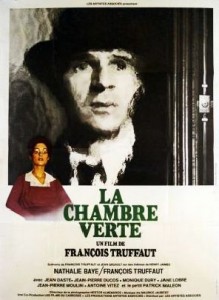Green Room, The (1978)
“The dead belong to us, as soon as we agree to belong to them.”
|
Synopsis: |
|
Genres, Themes, Actors, and Directors:
Review: We quickly see that Truffaut’s character (“Julien Devenne”) is a man unwilling to move beyond his past: he writes obituaries for a slowly dying newspaper, lives with an aging housekeeper, and is mortally offended at the notion of finding a new wife (an idea embodied by another recently widowed character shown in the film’s opening scene). Baye’s character is introduced as a potential source of joy and life for Julien, but their relationship is based on the slimmest of connections, and is never fully explained. Indeed, there are many elements of the screenplay that are insufficiently explained: Is the deaf-mute boy living with Julien his own son? (One presumes so, but we’re never given any context for his existence.) Why does Julien have such an interest in buying a particular ring sold at an estate auction overseen by Baye? And who in the world is the pivotal (unseen) character of Paul Massigny? Ultimately, the most memorable aspect of the film remains Nestor Almendros’ atmospheric cinematography, which relies heavily on natural light from the candles placed throughout the altars Julien constructs in memory of the dead. Redeeming Qualities and Moments: Must See? Links: |



2 thoughts on “Green Room, The (1978)”
First (and last) viewing. Not must-see.
This is among Truffaut’s most-forgotten films – and it’s not hard to see why. Naturally, it’s a worthy thing to hold dear the memory of loved ones who have passed on. But that’s a whole other matter outside of this film.
Aside from being more than a little preposterous, it’s often badly scripted and just about all of the acting is flat (esp. Truffaut’s). Poor Ms. Baye – trying her best – just doesn’t stand a chance with what she’s been asked to do.
This is simply a bad movie.
Not prime Truffaut, so I wouldn’t call a must see for anyone other than fans of a legendary director and/or international cinema.
I am a huge fan of Truffaut – The 400 Blows set an impression at a young age. His first three films are amazing. The rest of his filmography has some very good films.
The Green Room is a very personal film for Truffaut, and I’m frequently moved. It is a flawed film that is leaving an impression despite so many items not even opened to interpretation.
I’m glad I saw it as one of the few Truffaut films I haven’t seen, the cinematography and score, and especially for Nathalie Baye.